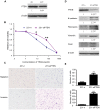Trail resistance induces epithelial-mesenchymal transition and enhances invasiveness by suppressing PTEN via miR-221 in breast cancer
- PMID: 24905916
- PMCID: PMC4048247
- DOI: 10.1371/journal.pone.0099067
Trail resistance induces epithelial-mesenchymal transition and enhances invasiveness by suppressing PTEN via miR-221 in breast cancer
Erratum in
-
Correction: Trail Resistance Induces Epithelial-Mesenchymal Transition and Enhances Invasiveness by Suppressing PTEN via miR-221 in Breast Cancer.PLoS One. 2019 Mar 21;14(3):e0214433. doi: 10.1371/journal.pone.0214433. eCollection 2019. PLoS One. 2019. PMID: 30897152 Free PMC article.
Abstract
Tumor necrosis factor-related apoptosis-inducing ligand (TRAIL) can selectively induce apoptosis of cancer cells and is verified effective to various cancers. However, a variety of breast cancer cell lines are resistant to TRAIL and the mechanisms of resistance are largely unknown. In our present experiment, we successfully utilized breast cancer cell line MDA-MB-231 to establish TRAIL-resistant cell line. We found resistance to TRAIL could induce epithelial-mesenchymal transition (EMT) and enhance invasiveness. We further demonstrated PTEN was down-regulated in TRAIL-resistant cells. Silencing miR-221, PTEN expression was up-regulated, the process of EMT could be reversed, and the ability of migration and invasion were correspondingly weakened. We also demonstrated knockdown of miR-221 could reverse resistance to TRAIL partially by targeting PTEN. Our findings suggest that resistance to TRAIL could induce EMT and enhance invasiveness by suppressing PTEN via miR-221. Re-expression of miR-221 or targeting PTEN might serve as potential therapeutic approaches for the treatment of Trail-resistant breast cancer.
Conflict of interest statement
Figures







Similar articles
-
Antagonism of miR-21 reverses epithelial-mesenchymal transition and cancer stem cell phenotype through AKT/ERK1/2 inactivation by targeting PTEN.PLoS One. 2012;7(6):e39520. doi: 10.1371/journal.pone.0039520. Epub 2012 Jun 25. PLoS One. 2012. PMID: 22761812 Free PMC article.
-
Knockdown of miR-25 increases the sensitivity of liver cancer stem cells to TRAIL-induced apoptosis via PTEN/PI3K/Akt/Bad signaling pathway.Int J Oncol. 2016 Dec;49(6):2600-2610. doi: 10.3892/ijo.2016.3751. Epub 2016 Nov 2. Int J Oncol. 2016. PMID: 27840896
-
miR-93 and PTEN: Key regulators of doxorubicin-resistance and EMT in breast cancer.Oncol Rep. 2017 Oct;38(4):2401-2407. doi: 10.3892/or.2017.5859. Epub 2017 Jul 31. Oncol Rep. 2017. PMID: 28765915
-
Targeting miRNAs associated with surface expression of death receptors to modulate TRAIL resistance in breast cancer.Cancer Lett. 2016 Dec 28;383(2):154-160. doi: 10.1016/j.canlet.2016.09.021. Epub 2016 Sep 28. Cancer Lett. 2016. PMID: 27693456 Review.
-
E-cadherin re-expression: Its potential in combating TRAIL resistance and reversing epithelial-to-mesenchymal transition.Gene. 2024 May 30;909:148293. doi: 10.1016/j.gene.2024.148293. Epub 2024 Feb 17. Gene. 2024. PMID: 38373660 Review.
Cited by
-
The E3 ubiquitin ligase NEDD4 is translationally upregulated and facilitates pancreatic cancer.Oncotarget. 2017 Mar 21;8(12):20288-20296. doi: 10.18632/oncotarget.15446. Oncotarget. 2017. PMID: 28423617 Free PMC article.
-
PP2A as the Main Node of Therapeutic Strategies and Resistance Reversal in Triple-Negative Breast Cancer.Molecules. 2017 Dec 20;22(12):2277. doi: 10.3390/molecules22122277. Molecules. 2017. PMID: 29261144 Free PMC article. Review.
-
TGFβ in Pancreas and Colorectal Cancer: Opportunities to Overcome Therapeutic Resistance.Clin Cancer Res. 2024 Sep 3;30(17):3676-3687. doi: 10.1158/1078-0432.CCR-24-0468. Clin Cancer Res. 2024. PMID: 38916900 Free PMC article. Review.
-
TRAIL promotes epithelial-to-mesenchymal transition by inducing PD-L1 expression in esophageal squamous cell carcinomas.J Exp Clin Cancer Res. 2021 Jun 24;40(1):209. doi: 10.1186/s13046-021-01972-0. J Exp Clin Cancer Res. 2021. PMID: 34167551 Free PMC article.
-
Salvianolic acid A reverses the paclitaxel resistance and inhibits the migration and invasion abilities of human breast cancer cells by inactivating transgelin 2.Cancer Biol Ther. 2015;16(9):1407-14. doi: 10.1080/15384047.2015.1070990. Cancer Biol Ther. 2015. PMID: 26176734 Free PMC article.
References
-
- Benson JR, Jatoi I (2012) The global breast cancer burden. Future Oncol 8: 697–702. - PubMed
-
- Youlden DR, Cramb SM, Dunn NA, Muller JM, Pyke CM, et al. (2012) The descriptive epidemiology of female breast cancer: an international comparison of screening, incidence, survival and mortality. Cancer Epidemiol 36: 237–248. - PubMed
-
- Griffith TS, Lynch DH (1998) TRAIL: a molecule with multiple receptors and control mechanisms. Curr Opin Immunol 10: 559–563. - PubMed
-
- Hotte SJ, Hirte HW, Chen EX, Siu LL, Le LH, et al. (2008) A phase 1 study of mapatumumab (fully human monoclonal antibody to TRAIL-R1) in patients with advanced solid malignancies. Clin Cancer Res 14: 3450–3455. - PubMed
-
- de Jong S, Timmer T, Heijenbrok FJ, de Vries EG (2001) Death receptor ligands, in particular TRAIL, to overcome drug resistance. Cancer Metastasis Rev 20: 51–56. - PubMed
Publication types
MeSH terms
Substances
LinkOut - more resources
Full Text Sources
Other Literature Sources
Medical
Research Materials
Miscellaneous

